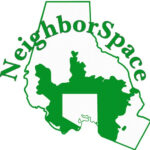Together with Wildside Nursery and the Greenbrier Garden Club, NeighborSpace installed 5 “pollinator patches” in the Greenbrier community on Saturday, October 26th.
It is well-established that pollinators are imperiled and populations are declining across the nation, largely due to disappearing habitat. The US Fish and Wildlife Service states that “conserving our nation’s pollinators and their habitat is key to conserving our land and waters, delivering natural solutions to the changing climate, and providing all Americans with access to nature and its many benefits”. In his third book, “Bringing Nature Home”, entomologist Doug Tallamy issued a call to action. The main idea of the book revolves around the concept of the “Homegrown National Park,” which encourages individuals to cultivate native plants in their yards, parks, and public spaces to create interconnected corridors of habitat that support local wildlife populations.
As an urban land trust, NeighborSpace believes that it is perfectly positioned to implement this concept. NeighborSpace sites are protected from development in perpetuity, provide enough square footage to install a high number and variety of native pollinator plants, and are centrally located in densely developed (sub-)urban neighborhoods. NeighborSpace’s vision is for each of its community open spaces to form a “node” of pollinator habitat, with habitat corridors radiating outwards across connected properties to form a “homegrown national park”. Ultimately, our vision is to create a network of pollinator habitats across NeighborSpace’s service area: urban Baltimore County.
For this small pilot in the Greenbrier neighborhood, we started at the community garden. After NeighborSpace staff shared a short introduction on the benefits of (replacing lawn with) native pollinator plants, Victor Bennett of Wildside Nursery shared information about specific native wildflower species and demonstrated proper planting technique. Neighborhood volunteers planted a new pollinator bed along the streetfront.
The group then moved through the neighborhood to install four residential pollinator patches. Properties were selected based on their proximity to the community garden, visibility, and growing conditions. Homeowners are committed to maintaining their patches and NeighborSpace staff will monitor the gardens and provide technical support for at least two years.
NeighborSpace hopes to scale up this approach for future iterations and install networks of pollinator habitat in neighborhoods that include a higher number of gardens and larger patches. We would also like to provide more robust education and encourage neighbors to take part in a community science program to collect observations of native plants and pollinators.
Thank you to Wildside Nursery for providing free labor and plant material, and to the Greenbrier Garden Club for organizing the project. We hope to co-host a garden tour in the spring – stay tuned!
If you are interested in creating a network of pollinator patches in your neighborhood, please reach out to phyllis@neighborspacebaltimorecounty.org.
For more information, visit:
https://xerces.org/pollinator-conservation
